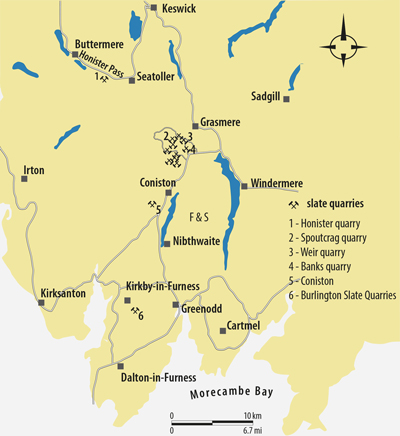 |
||
|
Slate deposits of the Lake District/Cumbria [UK] The Lake District be can devised in three different lithological zones: the Ordovician 'Skiddaw Slates' (= 'Skiddaw Group') in the north, the Ordovician 'Borrowdale Group' in the central part and the Silurian slates and limestones in the southern part. The Lake District belongs to the 'Lakesman Terrane' which borders to north to the 'Southern Uplands Terrane' and to south to the 'Southern Britain Terrane'. From the Welsh basin it is separated by the 'Monian Terrane'. Cumbria lies within the 'Southern Uplands Terrane'. In the Lake District the Ordovician ('Skiddaw Slate', 'Borrowdale Slate') and Silurian slates of the 'Borrowdale Group' are mined (Taylor et al., 1971). In the 19th century the term 'Skiddaw Slate' was primarily used for all sedimentary rocks and all volcanic sediments of the same age which lie below the 'Borrowdale Volcanic Group'. Afterwards, Wadge (1978) used this term for the sediments of the Arenigian which lie below the 'Eycott Volcanic Group'. At this point the term 'Skiddaw Group' should be applied for sequences of turbidites and the term 'Eycott Volcanic Group' should be applied to all lava and tuffites which are of the same age as the 'Skiddaw Group'. The author follows hereby the suggestions of Moeseleys (in Duff et al., 1992).
Slate quarries in Cumbria
The 'Skiddaw Group' comprises mudstones, siltstones and sandstones (turbidites) which were deposited in a relative stable deep water slope, running parallel to the rim of the Anglo-Gondwana continent (Cocks & Fortey 1982 cited in Duff et al., 1992). Within the Arenigian of the 'Skiddaw Group' one can distinguish the 'Hope Beck Slates' and the younger 'Kirk Stile Slates'. The 'Kirk Stile Slates' have sometimes a fracture cleavage which is parallel to the bedding.
At Coniston, Honister, Kirkstone and Langdale the green slates of the Ordovician 'Borrowdale Volcanic Group' are mined and they show a olive-green, black or black-bluish colour. This group has a total thickness of about 19,685 ft. comprising calc-alcali rocks and the dominating andesitic lava and tuffs. Within the tuffs there are subaqueously deposited horizons with a well developed bedding as well as subaerially deposited horizons
with only a weakly developed cleavage plane (Bassett et al., 1992). |
